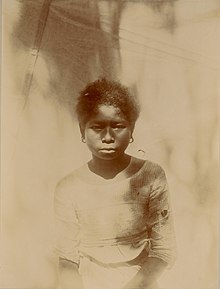
Back شعب أيتا Arabic Aetalar Azerbaijani Agta BCL ཨའེ་ཏ་མི། Tibetan Aeta German Aeta Spanish Agtat Finnish Aeta French आएता लोग Hindi Suku Aeta ID
| |
|---|---|
 | |
| Total population | |
| 50,236[1] | |
| Regions with significant populations | |
| Languages | |
| Philippine Negrito languages, Kapampangan, Filipino, English | |
| Religion | |
| Christianity, Anito, folk religions | |
| Related ethnic groups | |
| Batak, Manobo, Mamanwa; other Negrito peoples |
Aeta (Ayta /ˈaɪtə/ EYE-tə), Agta and Dumagat, are collective terms for several indigenous Filipinos who live in various parts of Luzon island in the Philippines. They are also known as the "Philippines Negrito"; and they are included in the wider Negrito grouping of Southeast Asia, with whom they share superficial common physical characteristics such as: dark skin tones; short statures; frizzy to curly-hair; and a higher frequency of naturally lighter hair colour (blondism) relative to the general population. They are thought to be among the earliest inhabitants of the Philippines — preceding the Austronesian migrations.[2][3] Regardless, the modern Aeta populations have significant Austronesian admixture, and speak Austronesian languages.[4]
Aeta communities were historically nomadic hunter-gatherers, typically consisting of approximately 1 to 5 families per mobile group.[5] Groups under the "Aeta" umbrella term are normally referred to after their geographic locations or their common languages.[6][7][8][9]
- ^ Cite error: The named reference
popwas invoked but never defined (see the help page). - ^ "The Aeta". peoplesoftheworld.org. Archived from the original on February 26, 2012. Retrieved June 16, 2012.
- ^ Larena, Maximilian; McKenna, James; Sanchez-Quinto, Federico (2021). "Philippine Ayta possess the highest level of Denisovan ancestry in the world". Current Biology. 31 (19): 4219–4230. doi:10.1016/j.cub.2021.07.022. PMC 8596304. PMID 34388371.
- ^ Cite error: The named reference
Reid2was invoked but never defined (see the help page). - ^ Allingham, R. Rand (December 2008). "Assessment of Visual Status of the Aeta, a Hunter-Gatherer Population of the Philippines (An AOS Thesis)". Transactions of the American Ophthalmological Society. 106: 240–251. ISSN 0065-9533. PMC 2646443. PMID 19277240.
- ^ Cite error: The named reference
Reidwas invoked but never defined (see the help page). - ^ Balilla, Vincent S.; Anwar McHenry, Julia; McHenry, Mark P.; Parkinson, Riva Marris; Banal, Danilo T. (2013). "Indigenous Aeta Magbukún Self-Identity, Sociopolitical Structures, and Self-Determination at the Local Level in the Philippines". Journal of Anthropology. 2013: 1–6. doi:10.1155/2013/391878. ISSN 2090-4045.
- ^ Rai, Navin K (1989). From forest to field: a study of Philippine Negrito foragers in transition (Thesis). Ann Arbor, Mich.: University Microfilms. OCLC 416933818.
- ^ Griffin, P. Bion (2001). "A Small Exhibit on the Agta and Their Future". American Anthropologist. 103 (2): 515–518. doi:10.1525/aa.2001.103.2.515. ISSN 1548-1433.